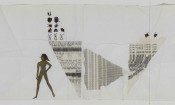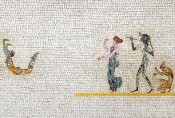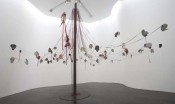Does the art of Nancy Spero put one in mind, above all, of books? This is the question raised by “Nancy Spero: Dissidances,” a retrospective of the fifty-plus years of the artist’s career jointly organized by the Museu d’Art Contemporani de Barcelona and the Museo Nacional Centro de Arte Reina Sofia in Madrid. Assembling an impressive quantity of Spero’s different projects, and drawing on their “allusions . . . to literary artifacts” such as codices, papyri, and manuscripts, curators Manuel J. Borja-Villel and Rosario Peiró propose to “re-evaluate [Spero's] work . . . as a compendium of diverse writings,” and have thus selected the motif of the book as paradigmatic of her textual project. Spero’s “book,” they write, is “the mirror of the body,” its forms and figures exemplifying Hélène Cixous’s concept of écriture feminine – a performative, physical language whose rhythms and patterns serve to embody multiple meanings rather than encoding a singular one. The presentation of Spero’s work in the show bolsters the conceptual approach by prefacing each “chapter” of her oeuvre to date with prominent wall-mounted texts drawn from her interviews and statements.
In foregrounding psychoanalytic-deconstructionist feminism as its theoretical frame, this scheme follows what has become the accepted line on Spero’s practice (a situation partly sanctioned by Spero herself, who at one time suggested that she was “trying la peinture féminine”). The curators’ logic is clear and their conceit seemingly unimpeachable. Troublemakers like me, however, might ask whether the implementation comes at the cost of making Spero’s practice seem, frankly, too bookish. To order the viewer’s encounter so that one meets the artist’s words first and the art second is to risk making the art seem supplementary to or illustrative of the commentary. Spero appropriates textual material drawn from many cultural contexts, but she also, famously, hoovers up a transhistorical, transcultural repertoire of figurative imagery – featuring, from the early 1970s onward, only female personae – which she then copies, colors, enlarges, reduces or reverses, transforming it into large-scale drawings, murals, and three-dimensional works. In spirit, these processes feel essentially spontaneous, instrumental, even promiscuous, and not, as the current show implies, museological or intellectualizing.
The exhibition’s emphasis on contemplation over action and on a particular textual form (the book) whose consumption tends to be a private, silent affair is also problematic because Spero’s explicit activist-feminist mission has been to find a voice and speak aloud – to stake a place in public dialogue. Her art’s textual content recalls graffiti, flyers, bulletins, broadsheets, protest murals, affiches, and placards more strongly than books; her scripts celebrate the writing of the street-where Spero the agitator has often enough been found, banner in hand. Spero notes of her 1966-70 “War” series of paintings protesting the actions of the United States in Vietnam: “I meant them as manifestos, as giveaways.” If her art really is a “compendium of diverse writings,” then its scripts are declamatory open letters; the “War” series embodies this with particular urgency and continuing relevance.
To stress this is not to limit Spero’s work to the category of agitprop. Rather, it is to recall the artist’s own emphasis on the motivating force of her early experience of voicelessness and marginalization within the domestic sphere. It is also to recognize that her artistic approach represents one strand of the challenge to “master narratives” lodged by feminists and others within the cultural practices of the 1970s and ’80s; in addition, through its use of appropriation, it constitutes an instance of that period’s multifaceted “critique of expression” (in the convenient critical shorthand). Moreover, from today’s perspective, Spero’s effort to be heard can be shown to have succeeded, at least art-institutionally speaking: Having become a canonical name in feminist art in the ’90s, Spero is now canonical, period-with all the intriguing paradoxes that shift in status trails in its wake.
In keeping with the show’s curatorial premise, “Dissidances” began (at macba) with the most obviously literary of Spero’s productions: the Codex Artaud, 1971-72. Twenty-five of the thirty-three sections of this epic piece, littered with fragments of text taken from Antonin Artaud’s feverish writings, were on view. But its placement sent the unprepared viewer time-traveling in reverse through the exhibition, from the Codex via her Artaud paintings of 1969-70 and the “War” series to her early-’60s and late- ’50s paintings using oil, ink, and gouache. This made it harder to recognize Spero’s early figurative paintings (for instance, of lovemaking scenes) as inchoate, hardfought artifacts, arguably most telling as testaments to the artist’s dogged self-discovery as an exceptionally good draftswoman. They bear the evidence of repetitive cycles of drawing and erasure, a technique that brings to mind Harold Rosenberg’s 1952 line: “It’s not that, it’s not that, it’s not that.” With the “War” drawings, though, Spero began trusting her core ability – to orchestrate forms two-dimensionally, by graphic means. These images declare helicopters, planes, bombs, and napalm to be this, and this, and this. The obscene, violent imagery morphs in work by obsessive work, characteristically scraped into being with rapid, harsh, scrubbed brushstrokes. Their drawn indictment still hits home: At macba I overheard a visitor burst into an involuntary, infantile laugh at one image (Bomb Shitting, 1966), and then fall into mortified silence. It was the kind of inappropriate laughter one hears more often from audiences of demanding theater than in art galleries.
For the show’s current venue, however, the curators adopted a more conventional chronological arrangement, which must also help one see the ways in which her journey illustrates its era, quitting myths of existential authenticity and originality to arrive at a hard-won productive acceptance of the ventriloquial aspect of all expression. In the Codex Artaud, for example, attribution becomes a means of attrition in a battle for individual identity in a gender war. ARTAUD, ARTAUD, ARTAUD: Via the endlessly, even mockingly, reiterated citation of the male artist’s name, Spero grapples for control both over his words and over his status. The repeating image of a collaged head whose tongue sticks simultaneously out and in encapsulates the struggle’s violent paradox. The organ of speech forms both a dagger and a gag, choking the mouth that wields it. The work is riddled with dialectical contradictions such as this. Another instance is its simultaneous, paradoxical undercutting both of Conceptualist writing through expressivist, painterly means, and of painterly expressivism through writing. (Benjamin H. D. Buchloh discusses this in a 1996 essay reprinted in the exhibition catalogue.) Nearly forty years since its execution, the Codex remains utterly compelling.
Visitors who resisted the temptation at macba to speed on from the Codex into the body of the show might have noted a further tension, one that points forward to the artist’s most recent achievements and also raises problems for the critical orthodoxy regarding Spero’s practice. In this discursive frame (best evidenced in texts by Lisa Tickner and Jon Bird), her oeuvre is aligned with the subversion of classicism, Logos, and the symbolic order, and linked to the (privileged) terms of plurality, unfixity, carnival – that is, the Dionysian. But a hard look at the Codex shows that Apollo has gatecrashed Dionysus’s party. With its subtle manipulation of the textures and shades of paper, its eye-catching gilded details, and its counterbalancing of visual incident against blank space and figure against line, the Codex’s superficially unraveling aesthetic is haunted by order and control. Subsequent pieces – such as, to pick just three, The Hours of the Night, 1974, Notes in Time on Women, 1979 (neither of which is in “Dissidences”), and Goddess Nut, 1989 – consolidate the tendency; their poise, balance, and rhythm compel the use of the word elegant. As Spero’s career progresses, Apollo starts stealing the show; and with Artemis, Acrobats, Divas and Dancers, 1999-2000, Spero’s mosaic mural project for the Lincoln Center subway station in New York, Dionysus seems in danger of getting the bum’s rush. Although I must confess I know the piece only from reproductions, let’s risk an extravagant claim: This project is nothing short of exquisite. An Apollonian feat of judgment, of the precise balanced placement of figures, lines and frames, voids and solids, it looks to be the triumph of Spero’s later career thus far. If its strategy of celebrating female performers is accepted as a legitimate feminist operation, then it strongly implies, contra the concept of écriture féminine, that no form of language is essentially retrogressive or intrinsically antifeminist. Any and every form of expression is up for grabs, from human-rights reports of torture and abuse (Torture of Women, 1976) and Nazi pornography (Ballad of Marie Sanders, 2003) to the formal elegance of Artemis, Acrobats, Divas and Dancers.
Beyond brief catalogue notes, however, the current retrospective holds nary a clue to this last work’s existence (or to Spero’s other public murals – for instance, To Soar III, 1991, at Chicago’s Harold Washington Library Center). Granted, retrospectives of living artists don’t usually reconstruct or document in situ works that can’t travel (and, in passing, the curators must be congratulated on the significant tranche of Spero originals whose travel to Spain they have engineered). Yet the organizers of historical shows habitually find ways of representing the unborrowable, and in Spero’s case, the absence of the public mural projects means we miss a significant aspect of her achievement. These works reflect both her campaign for feminist audibility and her art’s playing-out of a dialectic of anarchy and control. Factored into her oeuvre, they shift our sense of its values.
The final gallery of the show at macba, however, gave any such sense a disorientating shove. It contained Spero’s 2007 Venice Biennale grand projét, Maypole: Take No Prisoners – a tall pole dressed with chains and scarlet and black streamers, decked with aluminum medallions shaped like decapitated heads and screenprinted with images of gurning (or maybe shrieking) faces. Formally, phenomenologically, and processually, this elaborately fabricated object seems apart from any clear category of sculpture or installation. It is perhaps best described as a drawing that has partially broken out into three dimensions. Dionysus here seems to be back with a vengeance. Spero’s title suggests a satiric intent toward war, and above all (one assumes) Iraq and the “war on terror,” but the identity of the heads is unclear; they might equally be victims or vanquished aggressors. This semantic instability is disturbing. It might remind us of Slavoj Zizek’s condemnation of the idea that a liberatory principle resides within the idiom of carnivalesque misrule. Carnival, he insists, equals “gang rape.” A salutary reminder: The category of the Dionysian, of the “free play of the signifier,” contains within it a dimension of monstrous violence.
“Dissidances,” then, albeit unwittingly, brings this new perspective into view in relation to Spero’s art, and despite its various strengths, the show leaves one eager for an overview that is at once less orthodox, intellectually riskier and more comprehensive. How might it be, for instance, if later-twentieth-century feminist theory were bypassed, and this body of work – with all its dangerous, unstable vitality and its contradictory Apollonian and Dionysian faces – rerouted directly through such theory’s éminence grise, Friedrich Nietzsche? That would be a dissident dance, with bells on. What are the chances?
“Nancy Spero: Dissidances” showed at Museu d’Art Contemporani de Barcelona between July 4 – September 24 2009 and was subsequently on view at the Museo Nacional Centro de Arte Reina Sofia, Madrid, from October 14 2008 to January 5 2009; it travelled to the Centro Andaluz de Arte Contemporàneo, Seville, from January 27 to March 22 2009.
Copyright Rachel Withers & Artforum International Magazine, Inc. 2009


